The B2B Manufacturing Marketing Guide
Discover how to generate right-fit leads, build brand authority, and drive sustainable growth.

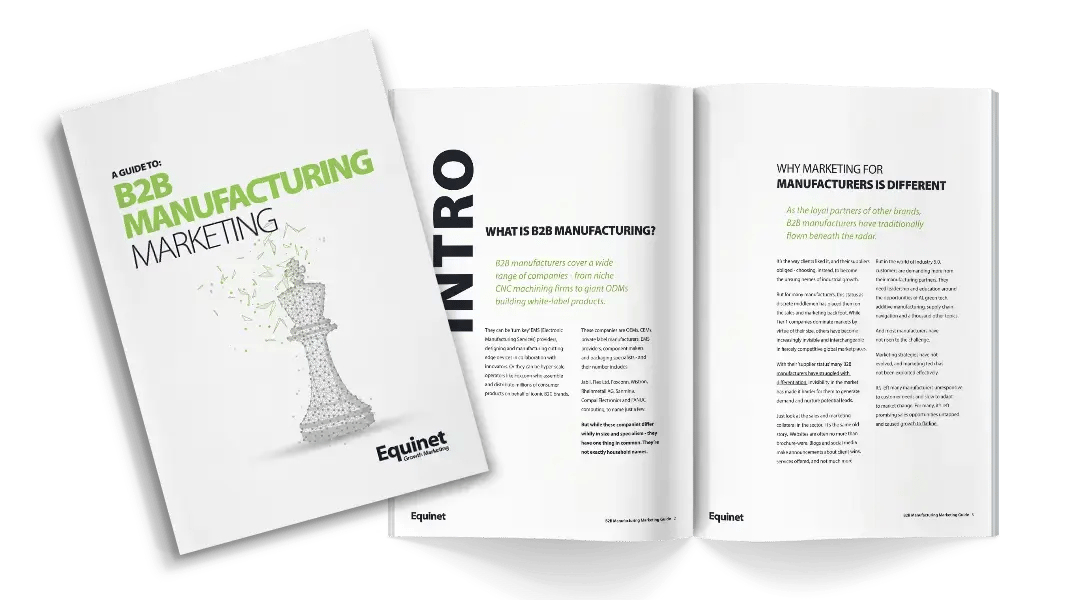
No time to read now?
At a glance:
|
What is B2B manufacturing?
B2B manufacturers encompass a diverse range of companies, from niche CNC machining firms to large ODMs that build white-label products.
They can be ‘turnkey’ EMS (Electronic Manufacturing Services) providers, designing and manufacturing cutting-edge devices in collaboration with innovators. Alternatively, they can be hyper-scale operators, such as Foxconn, which assembles and distributes millions of consumer products on behalf of iconic B2C brands.
These companies are OEMs, CEMs, private label manufacturers, EMS providers, component makers and packaging specialists - and their number includes:
Jabil, Flex Ltd, Foxconn, Wistron, Rheinmetall AG, Sanmina, Compal Electronics and FANUC computing, to name just a few.
However, while these companies differ significantly in size and specialisation, they share one commonality. They’re not exactly household names.
Why marketing for B2B manufacturers is different
As the loyal partners of their customers' brands, B2B manufacturers have traditionally flown beneath the radar.
It’s the way clients liked it, and their suppliers obliged - choosing, instead, to become the unsung heroes of industrial growth.
However, for many B2B manufacturers, this status as discrete middlemen has put them at a disadvantage in sales and marketing. Tier 1 companies dominate markets by virtue of their size. While others have become increasingly invisible and interchangeable in fiercely competitive global marketplaces.
With their ‘supplier status’ many B2B manufacturers have struggled with differentiation. Invisibility in the market has made it harder for them to generate demand and nurture potential leads.
Just look at the sales and marketing collateral in the sector. It’s the same old story. Websites are often no more than brochure-ware. Blogs and social media make announcements about client wins, services offered, and not much more.
But in the world of Industry 5.0, customers are demanding more from their manufacturing partners. They need leadership and education around the opportunities of AI, green tech, additive manufacturing, supply chain navigation and a thousand other topics.
And most manufacturers have not risen to the challenge.
Marketing strategies have not evolved, and marketing tech has not been exploited effectively.
It’s left many manufacturers unresponsive to customer needs and slow to adapt to market change. For many, it’s left promising sales opportunities untapped and caused growth to flatline.
To thrive in today’s market, B2B manufacturers must shed the cloak of invisibility, step into a leadership role in their sector, and use marketing to demonstrate the insight, innovation, and value they bring to their clients’ success.
B2B sales and marketing challenges in manufacturing
The challenges that face different B2B manufacturers are not all the same - and some are feeling the heat of the ‘undifferentiated middle’ more than others.
But most industrial companies are looking for new ways to grow and face off potential disruption.
1. The differentiation dilemma
ODMs and OEMs own the IP that can differentiate them in the marketplace. If you’re ASML and you are the only company in the world that makes the extreme ultraviolet lithography (EUV) machines that are required for semiconductor production, then your value proposition is obvious.
But contract manufacturers’ offerings can be more undifferentiated.
This lack of clear differentiation often forces them into a race to the bottom - competing on price rather than demonstrating unique value.
Here’s why:
The client concentration conundrum
Specialist equipment manufacturers often struggle to expand their client base and find new ways to grow - leaving them at risk when they lose key clients. Contract manufacturers can also find themselves focused on servicing a small number of demanding customers at the expense of building their pipeline. Even Tier 1 EMS providers like Foxconn are challenged by over-dependence on single ‘hero clients’.
Attracting the right clients
Private label manufacturers might be able to achieve quicker sales and turn around orders more rapidly because they’re selling generic products.
But OEMS and turnkey contract manufacturers working with innovating brands need to develop deeper relationships to sell more complex products. The deals they are seeking can be large, but timescales can be long. They need to attract, identify and convince multiple contacts buried deep in organisations - and they need to nurture and convert these relationships over time.
Decoding the modern marketing maze
In an ‘on-demand’ world, buyers are harder to reach and harder to engage than ever before. Outbound marketing is often a bust with manufacturers - who consciously avoid and reject sales contact. But choosing the right channels to reach and engage with ‘right fit’ prospects is challenging when media habits are so fragmented and individual.
Adapting to market change
No business can afford to stand still in a world where competitive threats can blow up seemingly overnight. In the manufacturing industry, there is always challenger tech emerging that can threaten business in previously uncontested spaces.
Even the semiconductor foundries of Taiwan are seeing their monopoly threatened as big tech brands look to take their own chip design and production in-house. Manufacturers need to be constantly looking ahead, testing new markets, and able to identify and pivot to new opportunities. To avoid disruption and keep generating demand, they need to be customer-oriented.
The power of brand value
In a world where perception can drive value, how do contract manufacturers craft a compelling and distinct brand narrative? The contract manufacturing landscape is crowded. Having a strong product or service is just the starting point. The real challenge lies in crafting a compelling brand narrative that resonates with potential clients and sets you apart from competitors.
2. The manufacturer’s buyers’ journey got more complex
In case you hadn’t noticed, B2B manufacturing buying decisions have become complex.
As the products companies are designing have become more sophisticated, buyers' choices and questions have multiplied.
And it’s making decision-making a lot harder and a lot longer.
%20(1)%20(1).webp?width=1201&height=458&name=manufacturing-prospect-stakeholders-b2b-deals%20(2)%20(1)%20(1).webp)
Source: Focus Digital, 2024; Gartner, State of B2B Buying 2022
Gartner says the typical B2B buyer’s journey now has six stages.
- Problem Identification
- Solution Exploration
- Requirements Building
- Supplier Selection
- Validation
- Consensus Creation
And they’re not linear. They’re crossing over, looping back and circling around. They’re terminating at key moments and shooting off in all directions. They can’t be contained in standard workflows.

In these industries, sales and marketing must operate in parallel, not serial, fashion.
But many manufacturers haven’t got the strategy or tech stack in place to navigate and control interactions with these buying networks.
3. AI is changing everything
The rise of artificial intelligence is reshaping how buyers research, evaluate and choose suppliers - and manufacturers are feeling the impact.
It’s now harder to be found digitally as AI tools are taking traffic away from websites.
%20(1)%20(1).webp?width=1201&height=251&name=The-New-Search-Landscape%20(2)%20(1)%20(1).webp)
Source: Search Engine Land
ChatGPT and Google AI Overviews are increasingly being used not just for information gathering, but for shortlisting and filtering suppliers before a human conversation begins.
Procurement teams are also experimenting with AI to benchmark potential partners on cost, performance and risk. This means suppliers can be ruled in - or out - long before their sales team has a chance to engage.
This shift creates a new kind of visibility challenge. If your marketing is not AI-ready - optimised for discoverability in AI-first search, built on credible thought leadership, and clear in its differentiation - you risk never appearing in the conversation at all.
The result? Many industrial marketers are getting left behind
The cumulative impact of these challenges is huge. Without a shift in approach, B2B manufacturers risk falling further behind.
B2B manufacturers are going all out on the digitisation of production lines and supplier management to meet these new customer demands. They’re looking to use AI, Quantum computing, robotics and additive manufacturing to collapse timelines and de-risk supply chains.
But while these companies have been digitising and automating production, they’ve not been doing the same with their marketing and sales capabilities.
There’s an imbalance between technical and marketing investment that is leaving them ill-equipped to deal with complex buyer networks.
%20(1).webp?width=1201&height=1576&name=Back-end-operations-vs-commercial-front-end%20(3)%20(1).webp)
Why marketing is central to manufacturing growth
With limited growth options for manufacturing companies in a crowded and mature market - mergers & acquisitions can often seem the only way to continue growing your business.
But if manufacturers are going to attract the right investment for the future, they need to ensure they have the strategies in place to keep generating demand and build more sustainable pipelines.
Right now, many manufacturers are relying on the sales team to fill pipelines, chasing harder-to-reach leads with only pricing levers to win new business. They’re using marketers to help run the same outbound campaigns and produce collateral for the same old trade fairs.
With complex buying networks, long buying cycles and emerging markets to navigate, this approach can only yield diminishing returns.
Sales teams can’t plot a growth strategy without pooling their insights around customer needs with marketing and account management teams. Sales and marketing alignment is central to identifying changing customer needs and new opportunities. And marketing is critical to developing the content that speaks directly to these needs.
But to achieve all this, manufacturers need a market-oriented rather than a service-oriented approach. They need a customer-first marketing strategy.
For many companies, this requires a complete sea-change in thinking about the role of marketing in their organisation.
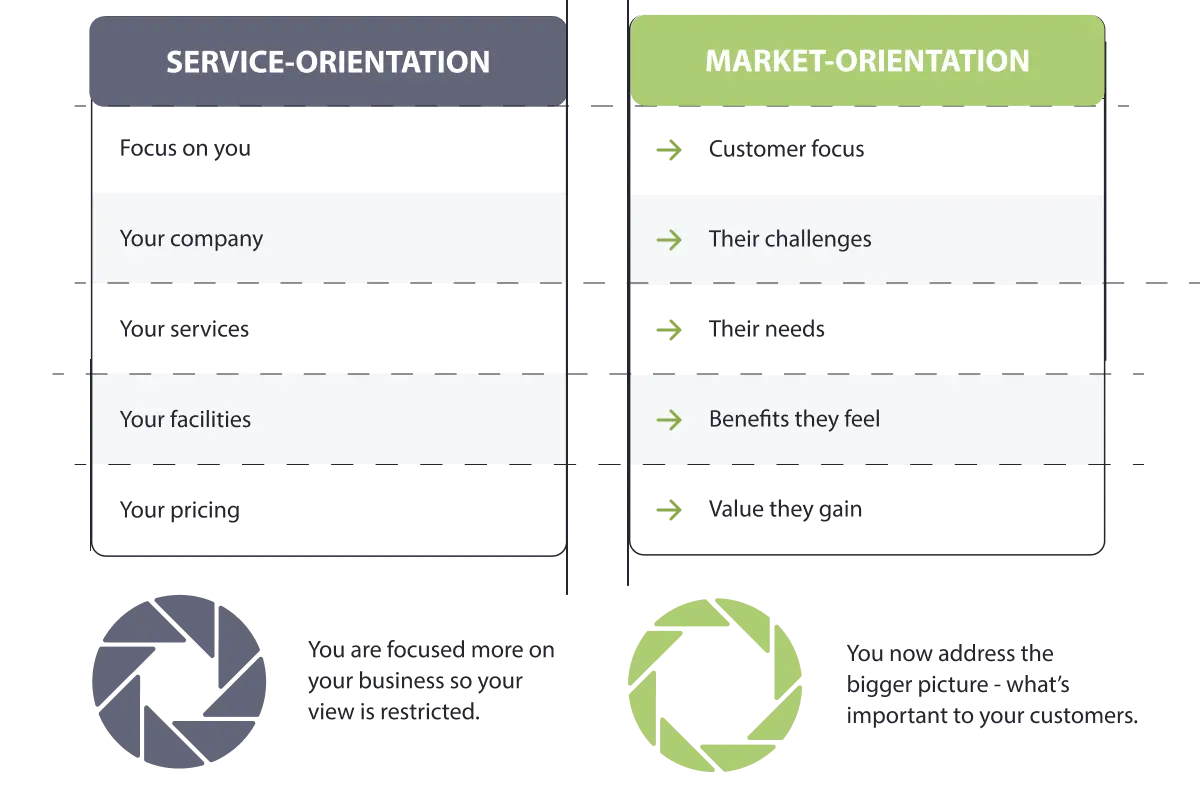
Building a growth-driven manufacturing marketing strategy
Operational excellence alone no longer guarantees growth. The manufacturers who thrive will be those who match precision on the production floor with precision in their front-end strategy.
That requires more than trade shows and refreshed brochures. It demands a modern, data-driven marketing approach built into your overall business strategy.
Together, commercial teams need to understand how their capabilities match customer needs so they can generate demand and build more sustainable pipelines.
Research the market
Market research and sizing can reveal opportunities - identifying untapped opportunities and highlighting where your business can make a significant impact.
Define your Ideal Customer Profile (ICP) and Buyer Personas
Deep knowledge and research about ideal customer profiles and buyer personas can show you how to reach and market to them more successfully. Build detailed buyer personas that capture their pain points, needs, and how your manufacturing solutions can address them.
Conduct competitor research
Understanding your competitors is as crucial as understanding your customers. Identify your closest competitors and consider where the unique strengths and weaknesses in these rival offerings lie. With competitor research, you can identify gaps in the market, benchmark your offerings, and differentiate your brand.
Craft a unique value proposition
Every manufacturer has something unique to offer, but understanding and articulating that uniqueness is where many fall short. Questions to ask yourself are:
- What specific value do you bring to your customers when they engage with your manufacturing company?
- How do you address their challenges and pain points more effectively than your competitors?
Armed with this information, manufacturers can understand the unique value they represent to their ideal customers and the buyers they are selling to. There are lots of tools that can help manufacturers identify their customers’ fundamental needs and map them against their products and services to define their unique value proposition. The value proposition canvas (invented by Strategzer) is a simple but powerful tool to help with this process.
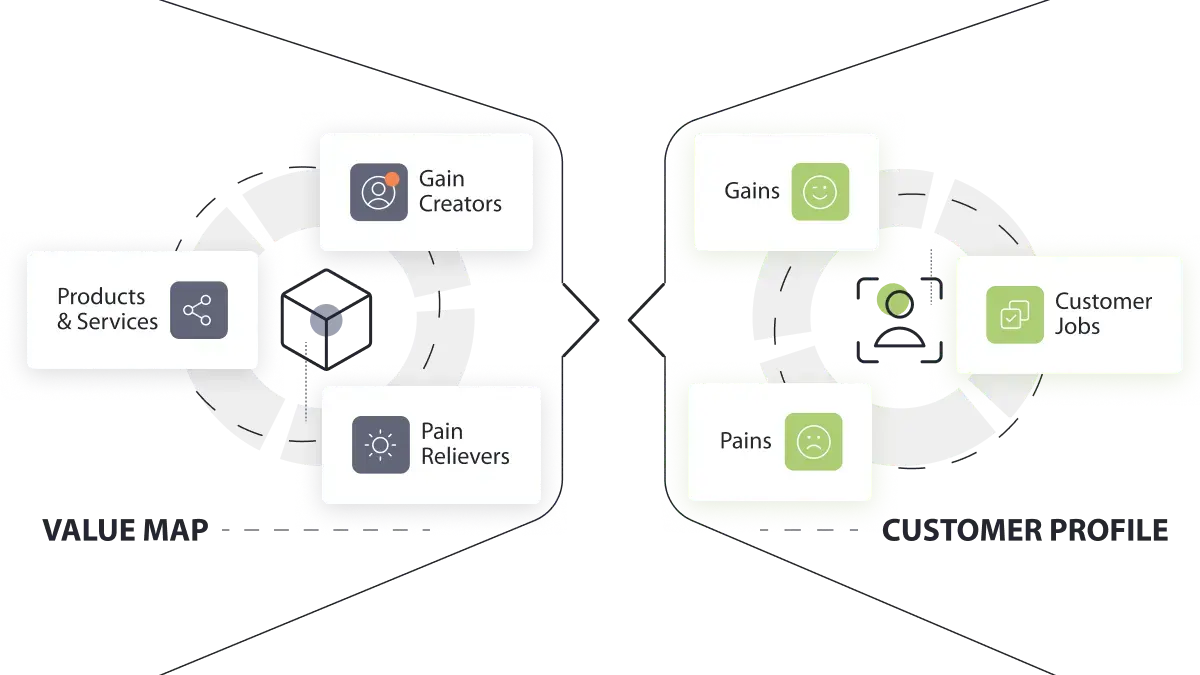
Begin with understanding your customer's 'jobs to be done' (JTBD) - the core tasks they aim to achieve with your business, which can be functional, social, or emotional. For instance, an OEM might aim to deliver products on time, maintain quality, and win suitable clients. They face challenges like factory upkeep costs and supply chain management but can gain benefits like meeting quality targets and focusing on sales.
The value proposition canvas helps manufacturers map out how their offerings alleviate these challenges and provide these benefits. By aligning their services with the customer's JTBD, manufacturers position themselves as a unique solution in the market, transcending commodity status and establishing a competitive edge.
With all this in place, manufacturers can develop a marketing strategy focused on growth.
How to create a compelling B2B manufacturing brand
Contract manufacturers need to transition from being invisible suppliers to proactive partners. This transformation requires a customer-oriented, digitised, and data-driven approach, aligning sales, marketing, and account management towards common goals.
But the cornerstone of this change is the brand.
A strong brand identity is more than just the image you project. It includes a deliberate choice about how you will conduct your business and how you will appear to anyone considering partnering with you. This involves being clear about your company's mission, vision, and values.
Establish a strong brand position
Brand positioning involves understanding your brand's unique place and purpose in the market. It can help you tell the stories that will win the attention of right-fit OEMs and engage them over long and complex sales cycles.
You need to know your particular strengths and express them to customers in a way that makes sense to them. They aren't just buying a solution from you. They are buying every aspect of how you deliver that solution.
Armed with your ideal customer profile, your competitor research and your value map, you can clearly see the position in the market where you will be able to thrive. This is the clear ‘blue ocean’, the place where you can successfully grow your brand away from predation by competitors, confident in the value you alone can offer your customers:

Develop strong brand messaging
Your brand messaging communicates your brand identity and helps potential customers decide whether you can meet their needs. It should attract OEMs whose problems you can solve while subtly signalling to unsuitable OEMs that you would not be a good partner for them.
It should include information about how your specific services and company culture alleviate the customer pains you have identified. Be explicit about customer gains and what you are uniquely able to provide.
AI also changes how brands are perceived. When buyers encounter your company through AI-generated summaries and recommendation engines, consistency and clarity in your brand narrative become even more important.
Digital marketing strategies for B2B manufacturers
Digital marketing is no longer a single tactic - it’s an ecosystem. For B2B manufacturers, success depends on how well your website, content, social media presence, targeting strategies, and revenue operations work together to attract, convert, and retain right-fit customers.
1. Turn your website into a digital growth engine
Your website is more than just a digital business card. It's a pivotal tool that can make or break potential partnerships.
Intuitive navigation, responsive design and fast-loading times are all important. But a user-friendly design isn't just about aesthetics. It's about creating a holistic digital experience that resonates with visitors and builds trust.
This means taking a customer-centric approach. Creating a successful manufacturing website isn’t about showcasing your company’s achievements but about addressing the needs and concerns of the OEMs you want to work with. By focusing on User Experience (UX) design, you can put customers first by creating a flow and journey that is meaningful and relevant.
Adopt Growth-Driven Design
Growth Driven Design (GDD) is a dynamic approach to website design that emphasises continuous improvement and agility. It involves constantly researching, testing and learning about visitors to your website to inform a programme of continuous improvements.
Instead of relying on assumptions, GDD focuses on real user data to guide design changes. This ensures that every tweak or overhaul addresses genuine user needs and preferences.
For example, by monitoring the percentage of visitors who take a desired action (like signing up for a newsletter or downloading an ebook), you can gauge the effectiveness of calls-to-action and other conversion elements and make tweaks as you see fit.
2. Master content marketing for manufacturers
Content marketing is a strategic marketing approach that focuses on creating content (like blogs, guides and videos) to attract, engage, and retain right-fit customers - and ultimately drive revenue.
On average, content marketing strategies cost 62% less than traditional B2B marketing programmes, while generating approximately three times the volume of leads - Content Marketing Institute (CMI)
Use inbound marketing as the bedrock
Inbound marketing serves as the foundation for content marketing, emphasising the attraction of right-fit customers through genuine value rather than direct promotion.
While content marketing provides the means - the blogs, guides, videos and other content - inbound marketing provides the strategy that guides how, when and why this content is produced and shared.
Create content with a point of view
In the AI age, everyone can generate content - but not everyone can create credibility. That’s why your content must come from a clear, consistent, and confident point of view.
Whether you’re creating a technical explainer, a whitepaper on compliance, or a video walkthrough of your production capabilities, you need to ask yourself:
- What do we uniquely understand about this issue?
- How does this help our buyers make a better decision?
- Are we simply adding to the noise - or cutting through it?
Generic content no longer earns attention - or clicks. You need to create a recognisable voice, show up consistently, and offer real insight that reflects both industry knowledge and commercial empathy.
Optimise for the new search landscape
Search engines are no longer just ten blue links - they're evolving into AI-powered answer engines.
For contract manufacturing companies, this means:
- More competition above the fold – AI summaries, featured snippets, and visual carousels often appear before organic listings.
- Fewer clicks, but higher intent – Buyers may get basic answers instantly, but will click through when they see something uniquely valuable, credible, and in-depth.
- Topical authority wins over keyword density – Search algorithms increasingly reward brands that cover their specialist topics comprehensively and consistently.
- Multi-format discovery discovery is rising – Search isn’t just Google anymore. LinkedIn, YouTube, Reddit, and even TikTok are becoming discovery platforms for complex B2B topics.
Manufacturers can no longer rely on sporadic blog posts or keyword-stuffed pages to drive visibility. Instead, success comes from building a deep, interconnected content ecosystem - pillar pages, topic clusters, downloadable guides, and video explainers - that reflects your domain expertise and aligns with how modern buyers actually discover and engage with content.
In today’s landscape, optimising for SEO alone isn’t enough. You also need to optimise for GEO - Generative Engine Optimisation - ensuring your brand, expertise, and content appear in AI-generated search results and summaries.
Utilise different content formats
By producing content assets across a range of mediums, you will engage customers in ways they value. At a time when noise is the enemy, this matters.
- Blogging: Make your website a valuable resource for customers through regular blogging.
- Pillar pages and topic clusters: Craft a central resource page, or pillar page, that delves deeply into a topic and links to related high-quality content, enhancing SERP rankings.
- Podcasts: Elevate your insight and knowledge in more digestible formats.
- Webinars: Educate, inform, or persuade potential customers about a particular topic.
- Research-based content: Conduct research on important issues for customers and share the results.
- Reports and guides: Create long-form content that provides in-depth information on a specific topic relevant to your audience.
- Magazines: While most content has gone digital, print provides an extraordinary opportunity to cut through.
- Video: Ideas include video demos, expert interviews, educational and explainer episodes, case studies, event promotion and sales videos.
Distribute and promote content effectively
Creating content is just half the battle. Ensuring it reaches the right audience is equally critical.
- Social media: Share and promote content on platforms where your potential clients are active.
- Email marketing: Regular newsletters can keep your audience updated with the latest content.
- SEO: Optimise content for search engines to ensure it ranks well and attracts organic traffic.
- Paid advertising: Boost reach and visibility for key pieces of content through targeted ads.
3. Social media marketing for B2B manufacturing companies
By strategically positioning your company on the right social media platforms, you can connect with OEMs, showcase your expertise, and drive meaningful business engagements.
Social media isn’t just for visibility - it’s where buying journeys begin, reputations are formed, and expertise is proven. Decision-makers now research partners long before a sales conversation, and what they see (or don’t see) on social channels influences trust.
For B2B manufacturers used to staying behind the scenes, social platforms provide a stage to demonstrate authority, humanise the brand, and join the conversations shaping their industry.
And with AI shaping what content gets surfaced and amplified, showing up with the right message in the right place has never been more critical.
Choose social media platforms with purpose
Where are OEMs spending their time? As a contract manufacturer, LinkedIn is likely to be the most important social media platform for you.
However, don’t overlook emerging or niche platforms where technical buyers are actively seeking insight:
- Reddit - Subreddits like r/AskEngineers or r/manufacturing are growing hubs for technical questions and peer-led vendor discussions.
- YouTube - Ideal for showcasing processes, product walkthroughs, or behind-the-scenes capabilities.
- TikTok & Instagram - While traditionally not B2B, short-form videos can build brand awareness and highlight your innovation culture - especially for attracting talent.
Each platform serves a different purpose - choose based on where your buyers are, not just your competitors.
Create social media content that delivers value
On social media, attention is earned - not given. Focus on producing content that genuinely resonates, including:
- Industry commentary or trends from your leadership team
- Infographics that simplify complex manufacturing processes
- Short videos showing machinery in action or explaining certifications
- Behind-the-scenes posts that build transparency and trust
Social platforms are increasingly governed by AI-powered algorithms, which favour relevance, authority, and engagement. That means content needs to be distinctive, expert-led, and audience-aware.
Encourage internal experts - engineers, project leads, commercial directors - to contribute. Employee advocacy can dramatically increase reach and authenticity.
Leverage paid advertising channels for targeted reach
Organic reach is valuable, but paid advertising can supercharge your efforts. LinkedIn and Facebook offer targeted advertising options, allowing you to reach specific demographics, job roles, or even particular companies. By investing in paid campaigns, you can ensure your content reaches those who matter most, driving more qualified leads.
Analyse and optimise social media campaigns
Don’t forget to regularly review the performance metrics of your posts and campaigns. Social media platforms provide insights into engagement rates, click-throughs, and even conversion metrics. By analysing this data, you can refine your strategies, optimise content for better performance, and ensure a higher return on investment.
4. Account-Based Marketing for B2B manufacturing companies
With long sales cycles, a one-size-fits-all marketing approach often falls short. Account-Based Marketing (ABM) is a focused strategy that treats individual accounts as unique markets.
ABM is a targeted sales approach that concentrates resources on a set of ideal customers. Using highly personalised campaigns, it attracts, engages, and converts pre-identified key accounts to secure transformative revenue growth.
Contract manufacturers must often persuade complex networks of engineers and other specialists to engage with them, typically months or even years before they are actually ready to buy. A personalised approach may be required to get your message through.
Identify high-value target accounts
The success of ABM hinges on finding the right accounts to target. Start by analysing your current customer base to identify characteristics of your most profitable and long-term clients. Consider factors like company size and past purchase behaviour. Collaborate with sales teams to create a list of potential high-value targets that align with these criteria.
Create personalised marketing strategies for key accounts
Once your list is in place, build tailored campaigns that speak directly to the priorities of each account - or even specific stakeholders within them.
This may include:
- Custom landing pages or microsites
- Personalised email outreach
- Targeted LinkedIn ads or InMail sequences
- Direct mail for standout engagement
Repurposing relevant content from your existing content strategy (e.g. sector-specific guides, case studies, or webinars).
AI can play a vital role here, helping you scale personalisation by analysing intent signals, website behaviours, and real-time engagement to trigger timely, relevant messaging that resonates.
ABM demands tight coordination between marketing and sales. Define shared goals, agree on what success looks like, and maintain ongoing collaboration throughout the journey.
Measure and evaluate ABM effectiveness
ABM is resource-intensive, so you need to track performance closely. Go beyond top-of funnel metrics and focus on account-level insights:
- Engagement across key stakeholders
- Movement through the buying journey
- Influence on deal velocity and pipeline growth
- ROI by campaign or channel
Use this data to refine your messaging, allocate budget more effectively, and prioritise the accounts most likely to convert.
ABM is not a quick win - but for contract manufacturers targeting strategic OEMs or Tier 1 suppliers, it’s a powerful way to build credibility, deepen relationships, and win bigger deals. By aligning marketing and sales around shared priorities and leveraging data-driven personalisation, ABM becomes more than a tactic - it’s a long-term growth strategy.
5. Take a Revenue Operations approach to growth
Revenue Operations (also known as RevOps) ensures alignment and accountability across the three departments responsible for driving revenue - sales, marketing, and customer service.
Create a unified revenue engine
Moving from traditional sales operations to a RevOps model:
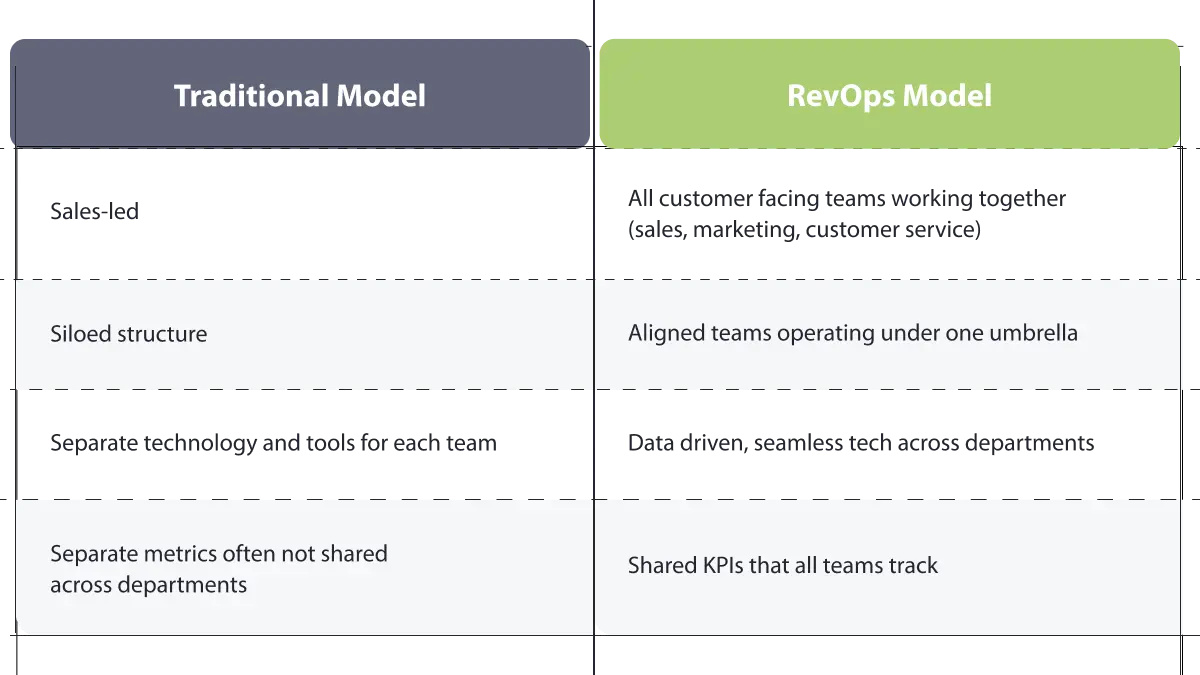
A successful RevOps model is focused around three pillars:
- Process: RevOps creates uniform processes to foster accountability and trust. As your teams combine to convert prospects into customers, you will see shorter sales cycles, improved retention, and a higher volume of upsells.
- People: You need people to bring together and manage your process and platforms - this may be a specific RevOps team, or accountabilities may be distributed amongst existing team members.
- Platform: Access to accurate information is key to success. By connecting and aligning your technology, you create a clear and precise story around your revenue pipeline, so your teams have clear directions for how they can impact the pipeline.
The alignment of processes, people and platforms in the RevOps model leads to maximised revenue. It ensures that all teams are working together to optimise the customer journey and drive growth. And as the business grows, the RevOps model ensures that operations are streamlined and aligned across all teams, enabling the business to scale efficiently.
6. Embrace AI as your marketing co-pilot
Throughout this guide, we've seen how AI is reshaping the buyer's journey, creating new challenges for visibility and engagement.
But AI is not just a disruptive force to be defended against. It's the single most powerful tool B2B manufacturers can leverage to execute the strategies we've discussed with more precision and speed.
Used strategically, AI becomes a co-pilot for your marketing team.
Loop marketing: The human+AI operating model
This integrated approach comes to life in Loop marketing, coined by HubSpot in September 2025.
Loop marketing is a continuous, data-driven cycle built for today’s non-linear buyer journeys. It combines AI efficiency with human authenticity to drive growth.
Here’s how it works:
- First, Express your brand identity as only you can. Define your taste, tone, and point of view before you bring in AI.
- Then, Tailor your messaging to your customers’ needs. Use AI to make personal, contextual, relevant interactions at scale.
- Next, Amplify to meet buyers where they are. Diversify your content across channels for both humans and AI.
- Finally, Evolve your content and strategy. Iterate quickly and more effectively with AI.
AI makes the Loop marketing cycle smarter, faster, and more scalable - so your growth strategy gets stronger with every iteration.
Where to start with AI?
You don’t need to adopt every AI tool overnight. In fact, the most effective AI strategies start by identifying clear use cases aligned with your existing challenges:
- Are you struggling to produce enough content? Start with AI-assisted content generation.
- Are you guessing at campaign timing? Use predictive engagement models.
- Are you unsure which leads are ready to buy? Add AI-driven intent scoring to your CRM.
Over time, you’ll shift from reactive marketing to a proactive, intelligent system that’s always learning, always improving.
That’s how AI helps you not just keep up, but lead in your market.
Summary: Your step-by-step guide for B2B manufacturing marketing
- 1. Build a customer-driven strategy rooted in research and a clearly defined value proposition.
- 2. Develop a credible brand to move you from invisible supplier to trusted partner.
- 3. Create a high-performing website with a strong value proposition and opportunities to convert.
- 4. Create a content ecosystem - pillar pages, blogs, guides, videos - with a clear point of view and optimised for AI-first discovery.
- 5. Show up on social media and create engaging, shareable content prioritising expert voices.
- 6. Adopt account-based marketing (ABM) to engage the right buyers with precision.
- 7. Use RevOps to align commercial teams and drive predictable growth.
- 8. Embrace AI as a marketing co-pilot to amplify your efforts.
Key takeaways & next steps for B2B manufacturing marketers
The contract manufacturing landscape is changing fast. OEM buyers are more informed, more selective, and more self-directed than ever before - and the competition for their attention is only intensifying.
Here’s what we’ve covered:
- Brand is a revenue asset - Strong positioning and a clear brand narrative can be the deciding factor in winning OEM trust.
- Buyer journeys are non-linear - Plan for multiple stakeholders and elongated cycles.
- Marketing drives pipeline health - Treat brand, website, and content as pipeline infrastructure, not collateral.
- Authority beats volume - Insight-led content with a point of view will outperform generic output in the age of AI.
- RevOps creates predictability - With shared data, shared definitions, shared KPIs, forecasting and retention improve together.
- AI is the unifying force - Use it to analyse, personalise, and predict; keep humans for judgement and originality.
Putting it into action
Now you know the strategies for growth, the next step is deciding how to implement them. You have three main options:
- 1. In-house – Empower your existing marketing team (or build one) to own the strategy. This offers maximum control but requires the right skills, tools, and time to execute effectively.
- 2. Hire – Recruit a dedicated marketing leader (if you don’t already have one) to design and deliver your growth plan, building a team around them as needed.
- 3. Partner – Work with a specialist B2B manufacturing marketing agency to bring proven strategy, execution, and sector expertise without the overhead of a full team.
The bottom line:
The manufacturers that will win the next decade are those willing to invest in brand, data, and digital capability - not just on the shop floor, but in every customer-facing interaction.
Ready to put these strategies into action?
Book a discovery call with our team to explore how we can help you stand out, generate more right-fit opportunities, and build a marketing engine that drives sustainable growth.
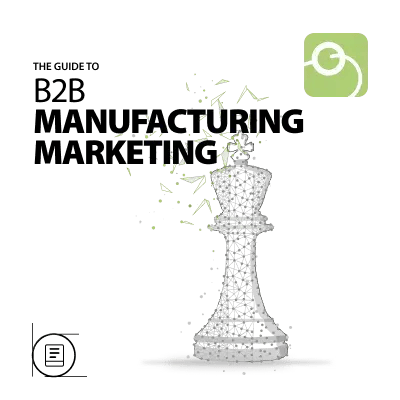
Want to save a copy? Well send a copy direct to your inbox.
Still got questions about B2B manufacturing marketing?
Why is marketing important for B2B manufacturers?
Today’s buyers are doing their research long before they speak to sales - and if you’re not visible, relevant, and clearly differentiated online, you're not in the running. Marketing helps manufacturers build credibility, communicate their value, and attract the right customers by aligning sales and strategy with consistent messaging. It’s not about being flashy - it’s about being found, trusted, and chosen.
How do we generate leads if our service is complex or bespoke?
In B2B manufacturing, lead generation isn’t about mass appeal - it’s about relevance. A strong inbound and ABM strategy, combined with clear positioning and sector-specific content, helps you attract and qualify the right prospects, even for complex or highly customised solutions.
Does digital marketing really work for manufacturers?
Yes - digital is where your buyers start their journey. A well-structured website, targeted SEO, and industry-relevant content can generate visibility, build authority, and support your sales team by nurturing leads before they even get in touch. A clear, content-rich website also helps AI tools and search assistants surface your business more effectively, making you easier to find, understand, and trust at every stage of the buying process.
What channels should we focus on first?
Before diving into tactics or channels, start by defining your brand. That means getting clear on your value proposition, brand personality, and positioning - who you’re for, why you exist, and what makes you different. Without this foundation, marketing activity risks being inconsistent, ineffective, or attracting the wrong type of customer. A well-defined brand ensures every message and touchpoint reinforces your value - from your website to your sales conversations.




























